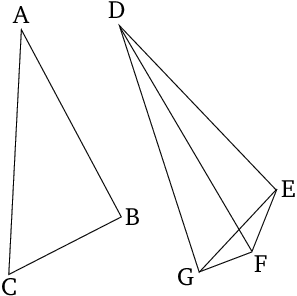If two triangles have two sides equal to two sides, respectively, but (one) has the angle encompassed by the equal straight lines greater than the (corresponding) angle (in the other), then (the former triangle) will also have a base greater than the base (of the latter).

If in two triangles \(\triangle{ABC}\), \(\triangle{DEF}\) we have two pairs of sides in each triangle respectively equal to the other, (without loss of generality assume \(\overline{AB}=\overline{DE}\) and \(\overline{AC}=\overline{DF}\)), where the interior angle in one triangle is greater in measure than the interior angle of the other triangle (\(\angle{BAC} > \angle{EDF}\)), then the remaining sides of the triangles will be unequal in length; specifically, the triangle with the greater interior angle will have a greater side than the triangle with the lesser interior angle (\(\overline{BC} > \overline{EF}\)).
Proofs: 1
Proofs: 1 2 3 4 5 6
Propositions: 7